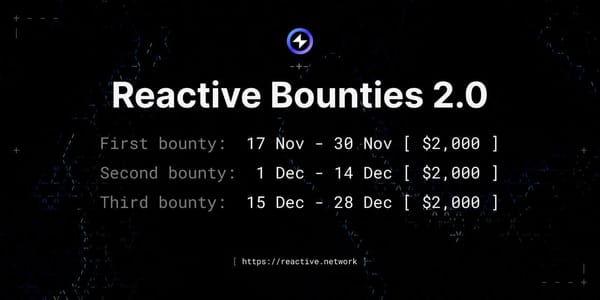Dynamic NFT Royalty System
The Dynamic NFT Royalty System uses Reactive Smart Contracts to enable real-time royalty adjustments, automate cross-chain transactions, and ensure transparent, fair revenue distribution for creators, buyers, and marketplaces.

Introduction
The NFT ecosystem grapples with a fundamental problem: royalty enforcement and dynamic pricing. Despite creators establishing royalty rates during minting, these figures are often circumvented by marketplaces, remain inflexible to market fluctuations, and fail to accommodate cross-chain transactions. The result is a staggering $1.8 billion in annual royalty losses, highlighting the inefficiencies of traditional smart contracts. These contracts can’t autonomously monitor cross-chain sales, adjust royalty rates based on market trends, or enforce payments consistently across platforms, leaving creators without a transparent way to track earnings.
Redefining NFT Royalty
Reactive Smart Contracts (RSCs) offer a solution to the NFT royalty challenge. The implementation, based on the project of Hackathon second-place winner Harsh Kasana, highlights the potential of decentralized finance to drive greater flexibility and accessibility into the NFT space. Unlike traditional smart contracts, which act only when directly invoked, RSCs are proactive and dynamic. They autonomously monitor blockchain events, self-trigger functions based on market conditions, and ensure multi-chain operations while maintaining consistent state across networks.
For NFT creators, this means a system that actively tracks sales across chains, adjusts royalty rates in real time, enforces payments uniformly across marketplaces, and delivers transparent, real-time royalty distribution.
Implementation
Core Smart Contracts
The following core smart contracts enable dynamic royalty calculations and secure cross-chain operations. Let’s take a closer look at what they do.
MarketMonitor.sol: Provides real-time market metrics like trading volume and sale prices for dynamic royalty calculations. It maintains historical price data, supports authorized data feeds, and includes pausing functionality for emergencies.
RoyaltyRegistry.sol: Manages NFT royalty configurations, including beneficiary details and dynamic rates. It adjusts royalties based on market trends, informed by metrics from `MarketMonitor`, and supports emergency pausing, operator roles, and secure access controls.
DynamicRoyaltyNFT.sol: An ERC-721 and ERC-2981 compliant NFT implementation supporting dynamic royalties. It integrates with `MarketMonitor.sol` for pricing adjustments and uses `RoyaltyRegistry.sol` for managing royalty distribution during sales.
WrappedNFTOnKopli.sol: Supports cross-chain NFT operations, including minting, listing, and unlisting, while leveraging REACT tokens for secure transactions. It ensures locked funds during purchases and enhances user experience with inventory tracking and detailed NFT listings.
Reactive Components
Two reactive components automate and synchronize cross-chain NFT transactions, ensuring integration between chains. Here’s a deeper look at what they accomplish.
STKReactive.sol: Automates cross-chain NFT management by reacting to events (`TokenLocked`, `TokenListed`, `TokenUnlisted`) on the origin chain. It emits callbacks to execute corresponding actions, like minting or listing, on the destination chain.
KTSReactive.sol: Facilitates NFT transfers by monitoring `TokensLocked` events and triggering callbacks to execute functions like `sendNFTToKopli()`. It ensures real-time synchronization between chains for cross-chain operations.
How It Works
The system is designed to enable NFT creation, cross-chain listing, and purchases across Ethereum Sepolia and Reactive Kopli. Here’s how it works:
Creating the NFT: The process starts when the creator mints a new NFT via the `DynamicRoyaltyNFT.mint(tokenId)` function. This triggers the initialization of the token in the `RoyaltyRegistry.sol` to set it up for future transactions.
Setting Up Royalties: After the NFT is minted, the creator configures its royalty settings using the `RoyaltyRegistry.sol`. This ensures the `MarketMonitor.sol` tracks the token’s data for analytics and royalty calculations.
Listing the NFT: The creator then lists the NFT by calling `DynamicRoyaltyNFT.list(tokenId, price)`, which broadcasts a `TokenListed` event. The `STKReactive.sol` picks up this event and replicates the listing on Reactive Kopli via `WrappedNFTOnKopli.sol`.
Buying on Sepolia: When a buyer purchases an NFT on Ethereum Sepolia, they initiate the transaction through `DynamicRoyaltyNFT.purchase(tokenId)`. The `MarketMonitor.sol` records the sale and calculates the royalty through the `RoyaltyRegistry.sol`. The NFT’s royalties are transferred to the creator, and the NFT itself is sent to the buyer.
Buying on Kopli: For cross-chain purchases on Reactive Kopli, the buyer locks the NFT by calling `WrappedNFTOnKopli.lockTokens(tokenId)`, which triggers a `TokensLocked` event. The `KTSReactive.sol` responds by sending the NFT to the `DynamicRoyaltyNFT.sol` contract on Ethereum Sepolia. This action emits an `NFTLocked` event, prompting the `STKReactive.sol` to mint the NFT on Reactive Kopli and transfer it to the buyer. The royalty handling for Kopli transactions mirrors the Sepolia flow.
Conclusion
The Dynamic NFT Royalty System reshapes the NFT ecosystem by addressing long-standing challenges in royalty enforcement and market adaptability. Through automated, real-time royalty adjustments, creators can recover up to 40% more revenue while benefiting from cross-chain earnings and comprehensive visibility into their transactions. Buyers enjoy reduced fees, transparent operations, and clear provenance, while marketplaces gain streamlined compliance and reduced operational costs.
By utilizing Reactive Smart Contracts, this system exemplifies how decentralized technology can bring flexibility and innovation to digital ownership. As the NFT space evolves, solutions like this not only secure creator revenues but also pave the way for more equitable markets. With its scalable design and forward-thinking approach, the system sets a new standard for royalty enforcement, marking a significant step forward in the future of decentralized assets.
About Reactive Network
The Reactive Network, pioneered by PARSIQ, ushers in a new wave of blockchain innovation through its Reactive Smart Contracts (RSCs). These advanced contracts can autonomously execute based on specific on-chain events, eliminating the need for off-chain computation and heralding a seamless cross-chain ecosystem vital for Web3’s growth.
Central to this breakthrough is the Inversion of Control (IoC) framework, which redefines smart contracts and decentralized applications (DApps) by imbuing them with unparalleled autonomy, efficiency, and interactivity. By marrying RSCs with IoC, Reactive Network is setting the stage for a transformative blockchain era, characterized by enhanced interoperability and the robust, user-friendly foundation Web3 demands.





